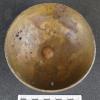Hemispherical silver bowl with gold appliqués (BM)
Commentary
Silver bowl with gold appliqués (BM). H. 0.069m; Diam. 0.103m; weight 188g. British Museum (BM 134740).
Hemispherical silver bowl, reportedly from Asia Minor, with sheet gold appliqués on the exterior. Series of "battlements" along the rim (similar to those on the Apadana at Persepolis). Two friezes of male royal figures walking r., 25 identical figures in each frieze, each wearing crown, robe, and bowcase, holding ring in r. hand and flower in l. hand.
Plain hemispherical drinking-vessels with a rounded bottom, although not as common as the “Achaemenid bowl” with carination and flared lip, appear in elite assemblages throughout the Persian empire, and this should probably also be considered as a distinctively Achaemenid form. For plain silver examples, see II. Özgen & J. Öztürk, Heritage Recovered: The Lydian Treasure (1996) nos. 51 and 52 (from İkiztepe). A plain gold example from the Oxus treasure can be seen here (= J. Curtis and N. Tallis, Forgotten Empire: The World of Ancient Persia (2005) p.113 no. 99); the prescribed material on this page also includes a bronze example from Deve Hüyük. On the Persepolis Apadana reliefs, hemispherical bowls appear in the hands of the Parthian delegation (Delegation XIII): G. Walser, Die Völkerschaften auf den Reliefs von Persepolis (1966), Tafel 62. For brief discussion, see P.R.S. Moorey, ‘The technique of gold-figure decoration on Achaemenid silver vessels’, Iranica Antiqua 23 (1988), 233-4.
J. Curtis and N. Tallis, Forgotten Empire: The World of Ancient Persia (2005), 118 no. 111.

